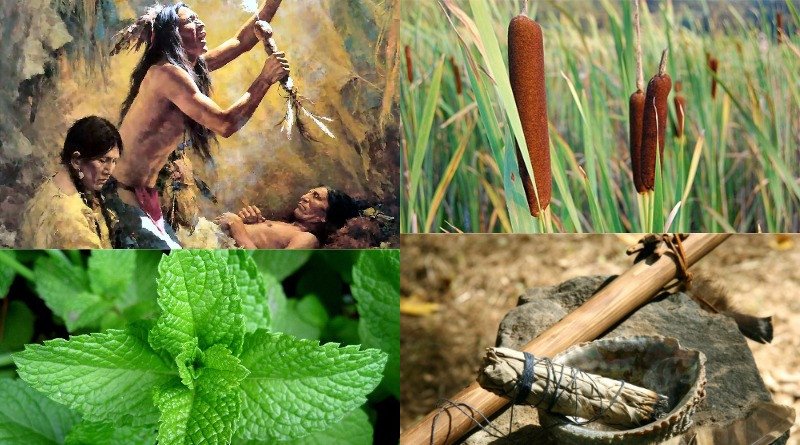11 Plants Native Americans Used to Cure EVERYTHING

The Cherokee, the Native American tribe trusted that the “Creator” gave them an endowment of comprehension and safeguarding medicinal herbs. The Cherokee confide in the mending and protection properties of nature’s pharmacy. The Cherokee advance appropriate gathering techniques of medicinal plants. The elders have shown them that in the event that you are gathering, you ought to just pick each third plant you find. This guarantees enough still remain and will keep on propagating. Here are the plants:
1. Wild mint
Mint is an exceptionally famous herb in present day culture and is generally utilized as a part of tea. Notwithstanding, many individuals don’t have a clue that mint contains an assortment of antioxidant properties. It likewise contains magnesium, phosphorus potassium, calcium, vitamin C, vitamin A, and fiber.
The Cherokee utilize this herb to help with digestion. The leaves can be smashed and utilized as cold compresses, made into ointments etc. The Cherokee healers utilize a mix of stems and leaves to lower hypertension.

2. Jisdu Unigisdi (Wild Rose)
This plant’s fruit is high in vitamin C and successfully treats seasonal influenza and common cold. The Cherokee arranged a mellow tea out of wild rose hips to invigorate the capacity of the kidneys and the bladder. The wild rose petal implantation can be utilized to calm your sore throat, and a decoction of the root will treat diarrhea.

3. Squirrel Tail (Yarrow)
This herb is known best for its blood thickening properties. New, smashed leaves can be put to open injuries to stop excess bleeding. Yarrow’s juice, blended with spring water, can prevent internal bleeding from stomach and intestinal diseases. You can likewise utilize the leaves to make tea which will invigorate stomach capacities and aid the process of digestion. It can likewise help with kidney and gallbladder related issues.

4. Qua lo ga (Sumac)
Each and every piece of this herb can be utilized for therapeutic purposes. Sumac bark can be made into a mellow decoction that can be taken to soothe diarrhea. The decoction from the bark can likewise be swished to help with a sore throat. The berries can make a lovely drink that is rich in vitamin C. The tea from the leaves of sumac can diminish fevers. You can even pound the leaves into a treatment to help alleviate a poison ivy rash.

5. Greenbriar
This plant’s roots are rich in starch, which is loaded with calories, however has a peculiar flavor. The stems and leaves are high in various minerals and vitamins. As it has a rubbery surface, you can utilize its roots like potatoes. This plant has been utilized as a mellow diuretic on account of urinary diseases and to clean the blood. Its bark and leaves have additionally been utilized for the arrangement of a ointment which mends burns and minor wounds. Its leaves can be added to tea with a specific end goal to treat joint inflammation.

6. Blackberry
This has been the most famous cure for problems with the stomach. It can also be used to soothe bleeding gums if you chew the leaves. You can make hack syrup by setting up a decoction from the roots, sweetened with maple syrup or honey. The strong tea from its root diminishes the swelling of the joints and tissues. The advantages of the blackberries include: reinforces the immune system, alleviation from endothelial brokenness, malignancy anticipation, healthy functioning of the heart and enhanced digestion.

7. Big Stretch (Wild Ginger)
The Cherokee tribe trusted that the mellow tea from the root of wild ginger invigorates processing of food, and treats stomach issues, colic, and intestinal gas. Also, the strong tea from the root of wild ginger can wipe out emission from the lungs. Another Native American tribe, The Meskwaki, cured ear diseases by using pummeled, splashes stems of wild ginger.

8. Cattail
This plant has been viewed as a powerful preventative medication, which is effortlessly digested and advances recuperation from different health conditions. Despite the seed heads and the mature leaves, every single other piece of this herb have therapeutic properties. Its root is rich in starch and the male plants are rich in pollen.
It can be prepared just like potatoes, boiled and mashed. This paste treats bruises and burns. Additionally, its pollen is rich in protein and can be utilized as a supplement in baking.

9. Mullein
This herb has the ability to alleviate asthma and chest congestion. As indicated by the Cherokee, breathing in the smoke from burning mullein roots and leaves works like magic for the lungs. Mullein is extraordinarily useful to calm the mucous membranes. You can make a warm decoction and soak your feet in it to decrease swelling and joint pain.

10. Hummingbird Blossom (Buckbrush)
Hummingbird bloom has been utilized by the Cherokee for treatment of cysts, fibroid tumors, aggravation, hypertension, lymphatic blockages and mouth and throat issues. The Cherokee basically utilize hummingbird bloom as a diuretic to fortify kidney work, nonetheless it was additionally used to treat conditions, for example, inflamed tonsils, augmented lymph hubs, augmented spleens, hemorrhoids and menstrual bleeding.
To get the majority of the advantages from hummingbird bloom, the Cherokee would soak the leave and blossoms in boiling water for around five minutes then drink the tea while it is still warm.

11. Kawi Iyusdi (Yellow Dock)
This herb has been used a lot in the kitchen, as it resembles spinach, yet consolidates a lot of minerals and vitamins. Its roots gather supplements from deep underground. Its leaves are high in iron and serve as a laxative. Set up a juice decoction out of the stems to reduce the shivering, minor wounds, or diaper rash. Additionally, the decoction from its crushed roots has powerful cleaning properties and can be used as a warm wash.

Source: nativeinyou.com



1 Comment
Greenmoksha · March 16, 2017 at 4:30 am
A very informative articles Would you like to share a guest blog on our portal.
Comments are closed.